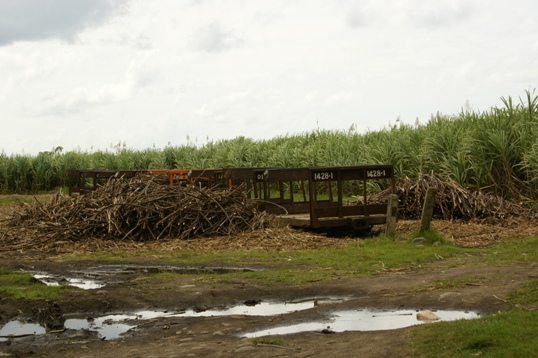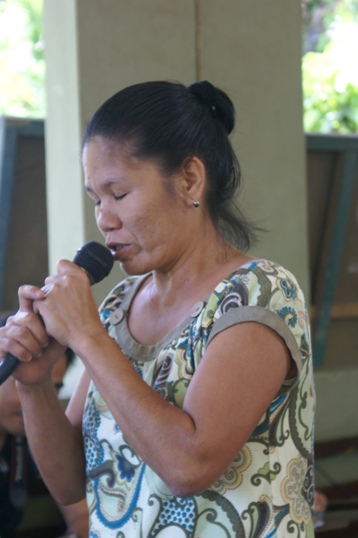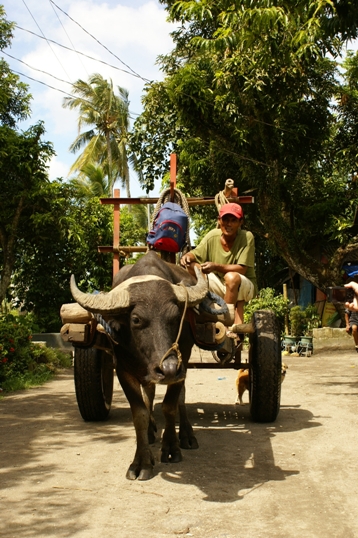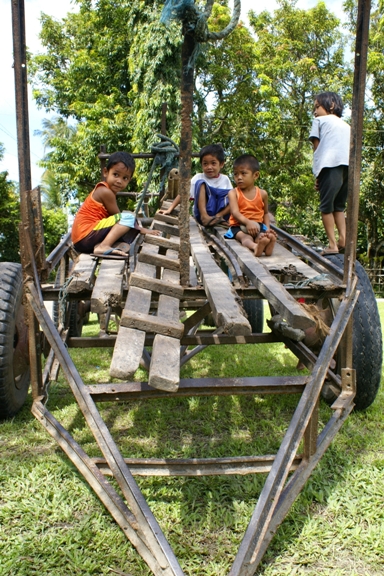What we saw during the Silay heritage tour we had during the Philippine Blog Awards Visayas was not the usual image of Silay with its grand mansions and affluent landowner-residents. I can say it was a Silay from the sacada perspective. Ver Pacete, Silay Tourism Officer brought us to Hacienda Adela to experience how the people continue to practice Ilonggo traditions handed down from generations.
Hacienda Adela used to belong to the Unson family and now divided among the heirs. Mr. Eduardo Margarito, Jr., the President of the Asosasyon sang mga Mangunguma sang Adela said that most residents trace back their roots to Panay. When the hacenderos from Panay settled in Negros, they brought with them the sacada workers, seasonal sugarcane plantation workers from Panay. Eventually, these workers got married and settled in Negros where their children found a new home just like Hacienda Adela where most sacada workers settled in the 1940s.

Life in the hacienda is a community affair. Everybody knows everybody and work, births, weddings and even deaths are shared with the community. Songs and dances play an important role in these occasions. The folks of Hacienda Adela performed to us a few composo songs acapella since their guitarist was in Silay for the Feast of San Diego.
Composo is an Ilonggo ballad which usually tells a story of love, sorrow, pent-up emotions, or whatever emotions the writer is going through. One performer hauntingly lamented through her composo her suffering under a physically abusive and lazy husband but still praying to God not to punish him with death.

The community shares a common devotion to San Roque (St. Roche) who was also the patron saint of their landlord. The feast of San Roque every August is an occasion where the folks of Hacienda Adela come together in their community center to sing and chant their prayers of adoration to the saint of dogs and those who love them. Some of their chants are in Latin and this reminds me of home.
Back in my hometown, we have a man who usually leads the prayer in a wake and he also chants in Latin. I cannot understand it except for the “ora pro nobis” or “pray for us”. He memorized the chants by heart and I guess only his age would make him forget a few lines thus he would look at his prayer booklet. Every time he chants in Latin we would heave a sigh of relief because that means he’s near the end of the prayer and we will be served with food.
I was glad to learn that what we also used to do back home is still being practiced by the folks at Hacienda Adela. As a child, I remember going to a belasyon or vigil for the dead the night after the dead has been buried. People would exchange what to my child’s ears were funny rhymes. What they were actually exchanging were luwa or loa, a form of Hiligaynon poem recited during a wake. It is usually designed to be funny to help lighten the feeling of loss of the bereaved family. The folks at Hacienda Adela performed some luwa for us and the exchange of banter through their luwa is quite fun to witness.

Work in the cane fields is undeniably backbreaking. Current rate for workers in the cane fields is P210 per day. Work would include weeding and planting of patdan (cane points). During harvest most jobs are paid pakyaw-basis, tapas (slashing) rate is P60 per ton while karga (loading) is P32 per ton. This is where the term kartaps came from when referring to these karga-tapas workers. Most trucks carry 8 to 10 tons of sugarcane so the kartaps are paid around P736 – P 920 per truck.

Residents of Hacienda Adela realized that the only way for their children not to suffer the same fate is through education. Most of their children are now college level and there are the luckier ones who graduated and end up with white collar jobs. Although most of the younger generation are no longer interested in continuing the old traditions, the elders continue to encourage them by involving them in various presentations of their oral traditions.
Hacienda Adela residents are living heritage treasures. We, bloggers hope that these folks continue to practice these oral traditions so that the younger generation can still experience them in the future and not just read about it in our blogs.

Are they not covered by the minimum wage law? Nalipat ko na you were once involved with CARP programs gali. So ano mahambal mo sa Hacienda Luisita.
They should but in reality syempre it doesn’t happen. Paano bi sila makapili sweldo kay amo lang na available nga obra. Well, although I’ve seen successes in some CARP beneficiaries, those are from more entrepreneurial farmers. I’m not an expert on CARP but these are based on what I saw in the field. There are CARP successes involving rice, pineapple and banana plantations. Those beneficiaries in Mindanao in pineapple and banana plantations are doing good. It’s a different case for sugarcane workers. Give land to a sugarcane worker who only knows weeding and you’re bound for failure. They wait 9-12 months to harvest sugarcane with inputs financed by loans and even their daily living expenses were borrowed. That’s why most of them had their land leased-back to their former landlords. Mayo pa kuno sg una nga gapangayo lang sila kay Toto kag Inday kay wala sila gapalibog maski sa pagpaeskwela sg ila kabataan. Perhaps, there will be more chance of success if Hacienda Luisita will be run collectively and not cut up and given to each farmer individually or if they totally forget about sugarcane and produce other high-value crops. There’s a collectively managed CARP area in Victorias City which is doing good and it should serve as a model for other CARP areas in Negros.
I’ve been looking for the going rate of wages for seasonal sugarcane field workers and I found it in what is essentially a travel piece. Its not rare for a travel piece to turn into a social commentary but this article was very good. Palakpak!
Thanks ‘day! We have to thanks Sir Ver Pacete who kept us updated on the rates in Silay. It could vary in other places. You know I used to go to the CARP areas a few years ago and I asked some of the ARBs how much they were paid. I was shocked to hear that some of them were paid as low as P60 a day for weeding. Even if both parents work, how are you going to feed a family of 4 kids with that wage? It’s heartbreaking. It also makes me think how I waste money through cellphone loads.
I like your articles, Glady. They are both informative and entertaining. I have read a number of old Philippine literature books and novels written in the early 1900s and re-released only recently (i.e. Pinaglahuan, Madaling Araw, Luha ng Buwaya, Anino ng Kahapon and the 3 novels of Lazaro Francisco namely Maganda Pa ang Daigdig, Daluyong and Ilaw sa Hilaga. Somehow, life in the haciendas and the sacadas are the subjects in these books. Indeed it is very fortunate that in Hacienda Adela, the culture and traditions are still very much alive. The younger generation must not let these traditions die.
Thank you Richard. I’m trying to read books written about Negros too. I guess hacienda life is a good subject for books both on a cultural and political perspective. It’s very volatile and until now there seem to be no end to their stories. Take the case of Hacienda Luisita. We can only guess how the Supreme Court’s decision will impact similar landholdings in Negros.
Great article! More like these about Negros culture and traditions that we wish to conserve, respect and showcase to the world!
Thank you Ms. Suzy. I still have a lot of stories waiting to be written. 😀
I love those stories!! I can tell you dozens of them from the Jersey pine barrens, from the battle of the Mullica river to the birth of the Jersey Devil!
Every culture has its own legend and folklore stories. It’s quite interesting how some of us still believes in aswang, our version of the vampire. What we Filipinos have today were mostly handed down orally from our forefathers.